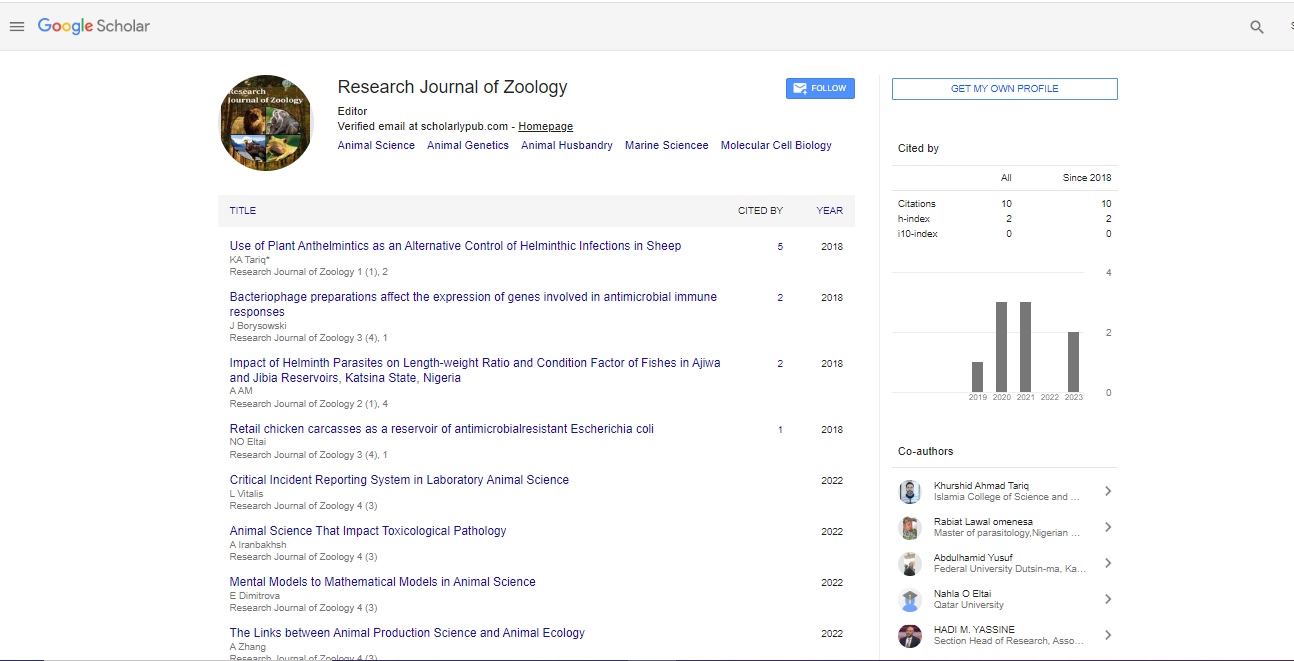Short Communication, Res J Zool Vol: 5 Issue: 1
Mastitis Infection: Cause, Treatment and Prevention
Simnein Zarie*
1Department of Animal Science, Islamic Azad University, Karaj, Iran
*Corresponding Author: Simnein Zarie
Department of Animal Science, Islamic
Azad University, Karaj, Iran
E-mail: simneinzar@gmail.com
Received date: 20-Feb-2023, Manuscript No. RJZ-23-93773;
Editor assigned date: 22-Feb-2023, PreQC No. RJZ-23-93773 (PQ);
Reviewed date: 09-Mar-2023, QC No RJZ-23-93773;
Revised date: 16-Mar-2023, Manuscript No. RJZ-23-93773(R);
Published date: 23-Mar-2023, DOI: 10.4172/Rjz.1000074.
Citation: Zarie S (2023) Mastitis infection: Cause, Treatment and Prevention. Res J Zool 5:1.
Description
Mastitis is a common and costly disease that affects dairy cattle worldwide. It is an inflammation of the mammary gland that can be caused by bacterial, viral, or fungal infections, as well as physical trauma or stress. Mastitis can result in decreased milk production, poor milk quality, and increased risk of culling or death in affected cows [1-3]. Symptoms of mastitis include swelling, heat, redness, and pain in the affected quarter of the udder, as well as changes in milk composition, such as increased somatic cell count or decreased milk yield. The diagnosis of mastitis is typically based on clinical signs and laboratory analysis of milk samples, which can identify the presence of bacteria or other pathogens. Mastitis can develop with or without infection [4-6]. If the inflammation does not occur as a result of an infection, it is typically caused by milk stasis. Milk stasis is the accumulation of milk within nursing women's breast tissue. Inflammation produced by milk stasis, on the other hand, usually progresses to infection-induced inflammation. This is due to the stagnant milk providing an environment for bacteria to develop. The most prevalent type of mastitis is caused by an infection. A flesh break or nipple can form from time to time. Bacteria, most commonly Staphylococcus aureus, penetrate this break and infect breast tissue.
Treatment and Prevention
Treatment of mastitis typically involves the use of antibiotics, which are administered either systemically or directly into the affected quarter of the udder [7]. In addition to antibiotic therapy, supportive care, such as frequent milking, proper nutrition, and adequate rest, can help to promote healing and prevent complications. Mastitis treatment entails reducing inflammation and pain while also avoiding infection [8,9]. Lactation and mastitis is constantly evolving, so it's critical to consult with your healthcare provider to ensure receiving the most upto- date treatment information. Mastitis was previously treated with heat, massage, and additional pumping or feeding wouldn't massage or use a heating blanket on an ankle injury. Mastitis should be handled in the same way. The swelling in your breasts is primarily caused by swelling of the tissues surrounding the milk. Rather, the inflammation must be reduced in order for the milk to run more freely. Prevention of mastitis is key to reducing the prevalence of the disease in dairy herds. This can be achieved through a combination of management practices, such as proper milking techniques, regular udder health monitoring, and hygiene protocols, as well as vaccination against common pathogens [10].
Conclusion
In conclusion, mastitis is a common and high disease that affects dairy cattle worldwide. While treatment and prevention strategies exist, the best approach to managing mastitis is a comprehensive, herd-level approach that focuses on prevention and early detection. By implementing best-practice management strategies and working closely with veterinary professionals, dairy farmers can help to reduce the incidence of mastitis and improve the health and productivity of their herds. Mastitis is a significant economic concern for the dairy industry, as it can result in decreased milk yield, increased veterinary costs, and decreased milk quality, which can lead to financial losses for dairy farmers. In addition, the use of antibiotics to treat mastitis can contribute to the development of antibiotic-resistant bacteria, which can pose a threat to both animal and human health.
References
- Audiger C, Rahman MJ, Yun TJ, Tarbell KV, Lesage S (2017) The importance of dendritic cells in maintaining immune tolerance. J Immunol. 198(6):2223-2231.
- Hasegawa H, Matsumoto T (2018) Mechanisms of tolerance induction by dendritic cells in vivo. Front Immunol. 9:350.
- Donnelly JJ, Liu MA, Ulmer JB (2000) Antigen presentation and DNA vaccines. Am J Respir Crit Care Med.162:S190-193.
- Bot A, Stan AC, Inaba K, Steinman R, Bona C (2000) Dendritic cells at a DNA vaccination site express the encoded influenza nucleoprotein and prime MHC class I-restricted cytolytic lymphocytes upon adoptive transfer. Int Immunol. 12(6):825-832.
- Smith TR, Schultheis K, Kiosses WB, Amante DH, Mendoza JM, et al. (2014) DNA vaccination strategy targets epidermal dendritic cells, initiating their migration and induction of a host immune response. Mol Ther Methods Clin Dev. 1:14054.
- Shi GX, Harrison K, Han SB, Moratz C, Kehrl JH (2004) Toll-like receptor signaling alters the expression of regulator of G protein signaling proteins in dendritic cells: implications for G protein-coupled receptor signaling. J Immunol. 172(9):5175-5184.
- Strange PG (2008) Agonist binding, agonist affinity and agonist efficacy at G protein‐coupled receptors. Br J Pharmacol. 153(7):1353-1363.
- Charlton SJ (2009) Agonist efficacy and receptor desensitization: from partial truths to a fuller picture. Br J Pharmacol. 158(1):165-168.
[Crossref][Google Scholar] [PubMed]
- Pollard C, De Koker S, Saelens X, Vanham G, Grooten J (2013) Challenges and advances towards the rational design of mRNA vaccines. Trends Mol Med. 19(12):705-713.
- Young CR, Ebringer A, Archer JR (1978) Immune response inversion after hyperimmunisation. Possible mechanism in the pathogenesis of HLA-linked diseases. Ann Rheum Dis. 37(2):152-158.
 Spanish
Spanish  Chinese
Chinese  Russian
Russian  German
German  French
French  Japanese
Japanese  Portuguese
Portuguese  Hindi
Hindi 
